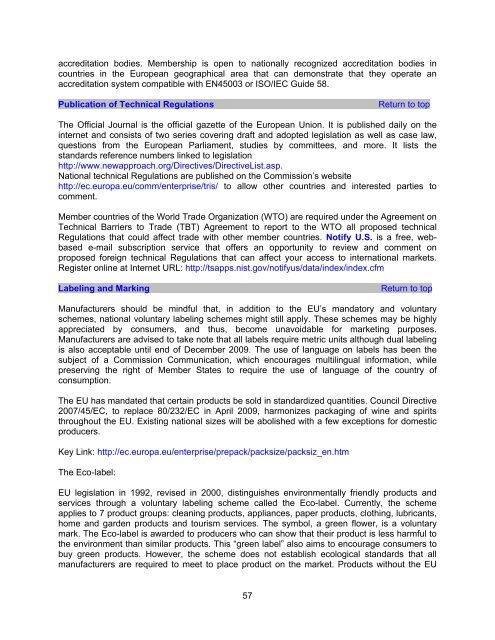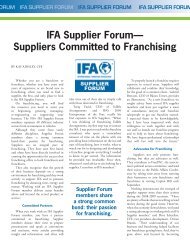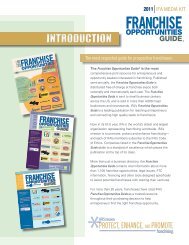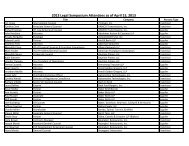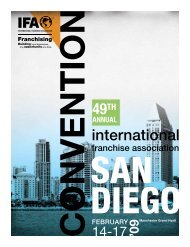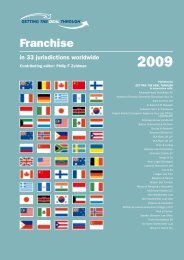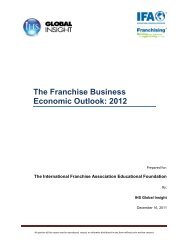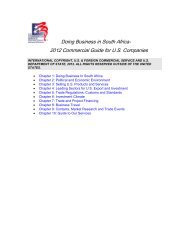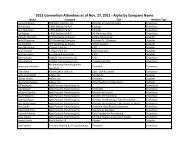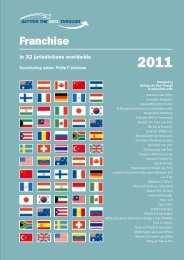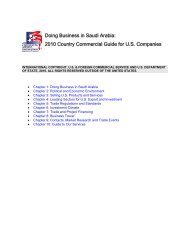Doing Business in Hungary 2010 - International Franchise Association
Doing Business in Hungary 2010 - International Franchise Association
Doing Business in Hungary 2010 - International Franchise Association
You also want an ePaper? Increase the reach of your titles
YUMPU automatically turns print PDFs into web optimized ePapers that Google loves.
accreditation bodies. Membership is open to nationally recognized accreditation bodies <strong>in</strong><br />
countries <strong>in</strong> the European geographical area that can demonstrate that they operate an<br />
accreditation system compatible with EN45003 or ISO/IEC Guide 58.<br />
Publication of Technical Regulations Return to top<br />
The Official Journal is the official gazette of the European Union. It is published daily on the<br />
<strong>in</strong>ternet and consists of two series cover<strong>in</strong>g draft and adopted legislation as well as case law,<br />
questions from the European Parliament, studies by committees, and more. It lists the<br />
standards reference numbers l<strong>in</strong>ked to legislation<br />
http://www.newapproach.org/Directives/DirectiveList.asp.<br />
National technical Regulations are published on the Commission’s website<br />
http://ec.europa.eu/comm/enterprise/tris/ to allow other countries and <strong>in</strong>terested parties to<br />
comment.<br />
Member countries of the World Trade Organization (WTO) are required under the Agreement on<br />
Technical Barriers to Trade (TBT) Agreement to report to the WTO all proposed technical<br />
Regulations that could affect trade with other member countries. Notify U.S. is a free, webbased<br />
e-mail subscription service that offers an opportunity to review and comment on<br />
proposed foreign technical Regulations that can affect your access to <strong>in</strong>ternational markets.<br />
Register onl<strong>in</strong>e at Internet URL: http://tsapps.nist.gov/notifyus/data/<strong>in</strong>dex/<strong>in</strong>dex.cfm<br />
Label<strong>in</strong>g and Mark<strong>in</strong>g Return to top<br />
Manufacturers should be m<strong>in</strong>dful that, <strong>in</strong> addition to the EU’s mandatory and voluntary<br />
schemes, national voluntary label<strong>in</strong>g schemes might still apply. These schemes may be highly<br />
appreciated by consumers, and thus, become unavoidable for market<strong>in</strong>g purposes.<br />
Manufacturers are advised to take note that all labels require metric units although dual label<strong>in</strong>g<br />
is also acceptable until end of December 2009. The use of language on labels has been the<br />
subject of a Commission Communication, which encourages multil<strong>in</strong>gual <strong>in</strong>formation, while<br />
preserv<strong>in</strong>g the right of Member States to require the use of language of the country of<br />
consumption.<br />
The EU has mandated that certa<strong>in</strong> products be sold <strong>in</strong> standardized quantities. Council Directive<br />
2007/45/EC, to replace 80/232/EC <strong>in</strong> April 2009, harmonizes packag<strong>in</strong>g of w<strong>in</strong>e and spirits<br />
throughout the EU. Exist<strong>in</strong>g national sizes will be abolished with a few exceptions for domestic<br />
producers.<br />
Key L<strong>in</strong>k: http://ec.europa.eu/enterprise/prepack/packsize/packsiz_en.htm<br />
The Eco-label:<br />
EU legislation <strong>in</strong> 1992, revised <strong>in</strong> 2000, dist<strong>in</strong>guishes environmentally friendly products and<br />
services through a voluntary label<strong>in</strong>g scheme called the Eco-label. Currently, the scheme<br />
applies to 7 product groups: clean<strong>in</strong>g products, appliances, paper products, cloth<strong>in</strong>g, lubricants,<br />
home and garden products and tourism services. The symbol, a green flower, is a voluntary<br />
mark. The Eco-label is awarded to producers who can show that their product is less harmful to<br />
the environment than similar products. This “green label” also aims to encourage consumers to<br />
buy green products. However, the scheme does not establish ecological standards that all<br />
manufacturers are required to meet to place product on the market. Products without the EU<br />
57


